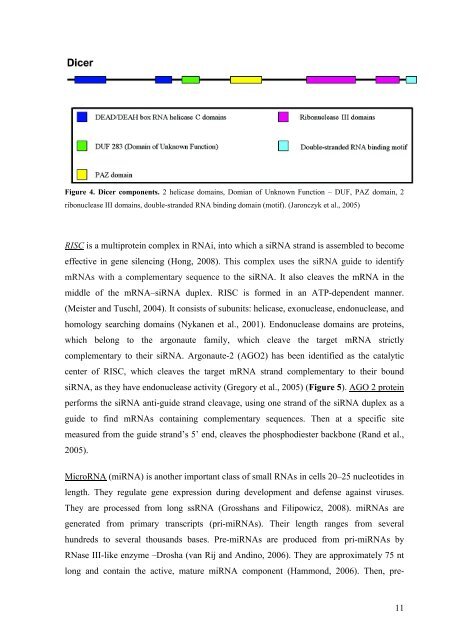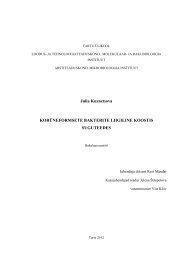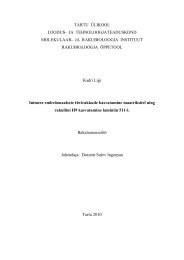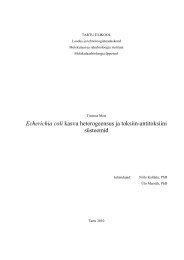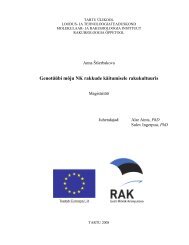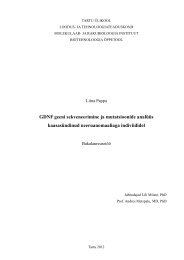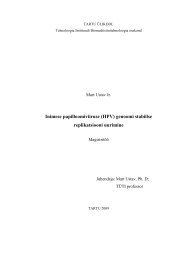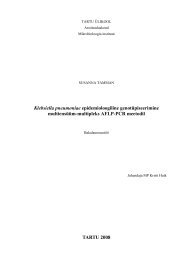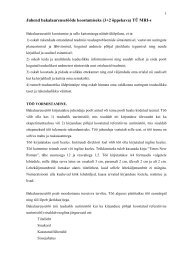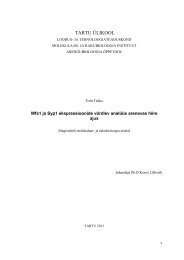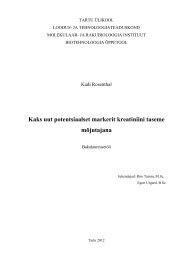Viruses and RNA interference in mammalian cells
Viruses and RNA interference in mammalian cells
Viruses and RNA interference in mammalian cells
Create successful ePaper yourself
Turn your PDF publications into a flip-book with our unique Google optimized e-Paper software.
Figure 4. Dicer components. 2 helicase doma<strong>in</strong>s, Domian of Unknown Function – DUF, PAZ doma<strong>in</strong>, 2<br />
ribonuclease III doma<strong>in</strong>s, double-str<strong>and</strong>ed <strong>RNA</strong> b<strong>in</strong>d<strong>in</strong>g doma<strong>in</strong> (motif). (Jaronczyk et al., 2005)<br />
RISC is a multiprote<strong>in</strong> complex <strong>in</strong> <strong>RNA</strong>i, <strong>in</strong>to which a si<strong>RNA</strong> str<strong>and</strong> is assembled to become<br />
effective <strong>in</strong> gene silenc<strong>in</strong>g (Hong, 2008). This complex uses the si<strong>RNA</strong> guide to identify<br />
m<strong>RNA</strong>s with a complementary sequence to the si<strong>RNA</strong>. It also cleaves the m<strong>RNA</strong> <strong>in</strong> the<br />
middle of the m<strong>RNA</strong>–si<strong>RNA</strong> duplex. RISC is formed <strong>in</strong> an ATP-dependent manner.<br />
(Meister <strong>and</strong> Tuschl, 2004). It consists of subunits: helicase, exonuclease, endonuclease, <strong>and</strong><br />
homology search<strong>in</strong>g doma<strong>in</strong>s (Nykanen et al., 2001). Endonuclease doma<strong>in</strong>s are prote<strong>in</strong>s,<br />
which belong to the argonaute family, which cleave the target m<strong>RNA</strong> strictly<br />
complementary to their si<strong>RNA</strong>. Argonaute-2 (AGO2) has been identified as the catalytic<br />
center of RISC, which cleaves the target m<strong>RNA</strong> str<strong>and</strong> complementary to their bound<br />
si<strong>RNA</strong>, as they have endonuclease activity (Gregory et al., 2005) (Figure 5). AGO 2 prote<strong>in</strong><br />
performs the si<strong>RNA</strong> anti-guide str<strong>and</strong> cleavage, us<strong>in</strong>g one str<strong>and</strong> of the si<strong>RNA</strong> duplex as a<br />
guide to f<strong>in</strong>d m<strong>RNA</strong>s conta<strong>in</strong><strong>in</strong>g complementary sequences. Then at a specific site<br />
measured from the guide str<strong>and</strong>’s 5’ end, cleaves the phosphodiester backbone (R<strong>and</strong> et al.,<br />
2005).<br />
Micro<strong>RNA</strong> (mi<strong>RNA</strong>) is another important class of small <strong>RNA</strong>s <strong>in</strong> <strong>cells</strong> 20–25 nucleotides <strong>in</strong><br />
length. They regulate gene expression dur<strong>in</strong>g development <strong>and</strong> defense aga<strong>in</strong>st viruses.<br />
They are processed from long ss<strong>RNA</strong> (Grosshans <strong>and</strong> Filipowicz, 2008). mi<strong>RNA</strong>s are<br />
generated from primary transcripts (pri-mi<strong>RNA</strong>s). Their length ranges from several<br />
hundreds to several thous<strong>and</strong>s bases. Pre-mi<strong>RNA</strong>s are produced from pri-mi<strong>RNA</strong>s by<br />
RNase III-like enzyme –Drosha (van Rij <strong>and</strong> And<strong>in</strong>o, 2006). They are approximately 75 nt<br />
long <strong>and</strong> conta<strong>in</strong> the active, mature mi<strong>RNA</strong> component (Hammond, 2006). Then, pre-<br />
11


